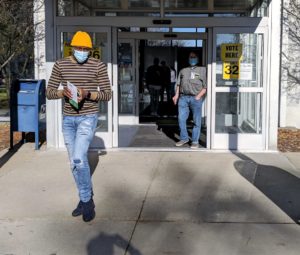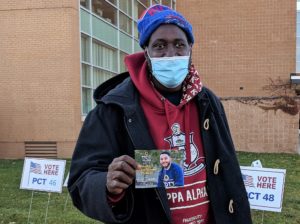By Paul Rozycki
In a year of pandemics, racial division, economic crisis, and the most divisive election in the last century, it’s a challenge to uncover the things that really matter in this year’s presidential election.
In the last weeks, we’ve all had wall-to-wall coverage and analysis of this year’s presidential contest. It may be months, or years, before we fully unravel the full impact and the meaning of the Trump presidency and its aftermath. And it may take as long to assess the impact of the Biden presidency as he begins to tackle the crisis of 2020. Yet, with those limitations, there are several things that have emerged from this year’s election that will matter for the future. In no particular order here’s a few significant takeaways from this year’s election.

President-elect Joe Biden outside Berston Field House in Flint during a 2020 Campaign stop. (Photo by Paul Rozycki)
There was no Blue Wave.
The victory of Joe Biden was certainly a reason to celebrate for Democrats. Yet, the expected Blue Wave, which was supposed to give Democrats a dramatic increase in membership in the U.S. Senate, House and state legislatures didn’t happen. While Democrats have a chance to win a majority in the Senate, based on two special elections in Georgia, they lost at least five seats in the House, and lost ground state legislatures. While the state legislatures didn’t get much coverage on election night, they are important because next year will be time to draw new election districts for the next decade, and state lawmakers lead the process.

A voter exiting Flint City Hall from voting in the 2020 General Election. (Photo by Paul Rozycki)
Is there a Blue Wall?
One of the biggest surprises in the 2016 election was Trump’s victories in the ‘Blue Wall’— the states of Michigan, Wisconsin and Pennsylvania, which had voted for Democrats for nearly the last 30 years. Everyone assumed that Hillary had those states in the bag and Trump took them all, giving him his margin of victory. Biden regained those states, but the margins were close, and the Blue Wall may more of a ‘Purple Wall’ in the future where either party has a chance of winning.
Demography is destiny.
It’s no surprise that the makeup of the nation’s population is always changing. Millennials are about to outnumber Baby Boomers and Black and Hispanic minorities are on track to outnumber whites in the decades to come. The election of Kamala Harris, as the first woman, Black, Asian, to be vice president highlights the direction of the country in the future. Based on current patterns that should favor Democrats.
How will both parties change?
The Republican Party has long been the party of business, limited government, balanced budgets and traditional values. They still retain much of that support but will they become the party of white, working class, union voters that have been part of the Democratic Party? With they become the party of Trump? Will the Democrats become the party of the urban, college educated and minority voters? Both parties may have a different look in the future. Traditional loyalties have shifted. Though a large majority of both Hispanic and Black voters typically support Democrats, an increasing number of both went Republican this year.
With Trump gone, what changes?
Will the Republican Party remain the party of Trump, or will it return to its traditional roots? Will the Democratic Party remain unified when they don’t have a Donald Trump to oppose? Will we see a return to a more civil politics between the parties? What role will Trump play, if any, in the Republican Party, or national politics? Without Trump, where will his supporters go?
Will the way we vote change?
The COVID-19 pandemic has changed much in our lives. This year we saw a dramatic increase in absentee or mail-in voting. Even after the pandemic is history, will this continue? This year, even with last minute rule changes and the need to adapt quickly to the new voting patterns, most state and local clerks did an admirable job, and there were few major problems nationwide. The absentee or mail-in vote allows voters to study the ballot in more detail, and gives them the flexibility to vote according to their own schedule, aiding those who might have work or other commitments on Election Day. It also provides a paper record of the vote, in case there are challenges. Several western states use mail-in voting with success and other states may take a second look at a larger use of the mail-in voting option.

A voter at their polling station on election day supporting a candidate. (Photo by Paul Rozycki)
Is the south changing?
While the traditional Midwestern, Democratic ‘Blue Wall’ may be fading to purple, several Republican states seem to be shifting in the same purple direction. Georgia, North Carolina and Arizona, once solid Republican states, all were considered tossup states this year, with Biden having a small lead in Arizona and Georgia.
What will happen in the next two months?
While Biden has won, he won’t take office until Jan. 20. What will be the reaction of the Trump administration? Will they accede to a peaceful transition or something else? Will Trump finally concede, or will he continue to claim that the election was fraudulent? Will he issue last minute executive orders or pardons? So far, there have been no violent demonstrations over the election. Will that hold for the next two months?
How will Biden deal with the major challenges he faces?
As we move to the new administration, the nation faces two major challenges. The COVID-19 pandemic is spiking in nearly every state, hospitals are reaching their limits, and it looks like the second (or third) wave of the pandemic will be worse than what we have seen in the past nine months. While a vaccine is on the horizon, it not here yet, and it may be many months before it’s widely available. Parallel to the COVID crisis is the economic crisis. Not only are millions still out of work and businesses closed, but the financial relief needed to fight the pandemic, will cause large budget problems for both the state and national governments, limiting their ability to deal with other issues. As he tries to resolve these crisis, Biden may be dealing with a divided government.

President-elect Joe Biden speaking at a Halloween day campaign rally in the parking lot of Flint’s shuttered Northwestern High School. (Photo by Tom Travis)
Can we restore trust in our major institutions?
Perhaps the major problem that we face after this election is dealing with the lack of trust in governmental, and non-governmental institutions. In recent decades there has been declining trust in many organizations, and Trump’s presidency played on that, and increased the distrust in the Congress, the political parties, the FBI, the military, medical professionals, the media, and the Postal Service, among others. Elections are the heart of democracy and his unfounded charges that the recent election was a fraud only makes matters worse, as few Republicans were willing to challenge him on his charges of wide-spread vote cheating and corruption. As we know all too well in Flint, once that trust is lost, it can take a very long time to restore it.
And finally, will we as a people, begin to restore trust in each other, and heal the partisan divisions of the nation? That may be our own task as much as Joe Biden’s.
EVM Political Commentator Paul Rozycki can be reached at paul.rozycki@mcc.edu.



You must be logged in to post a comment.